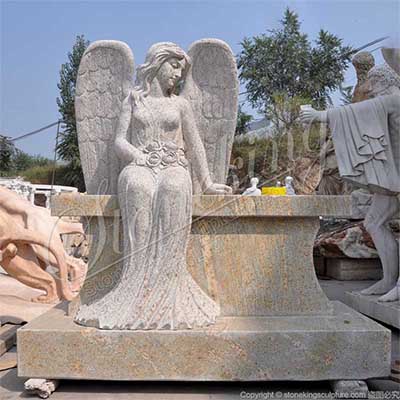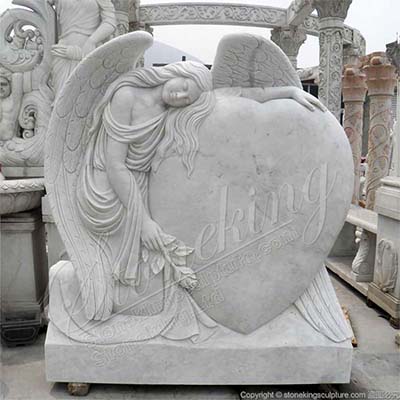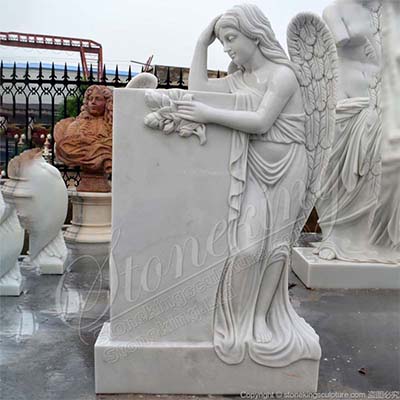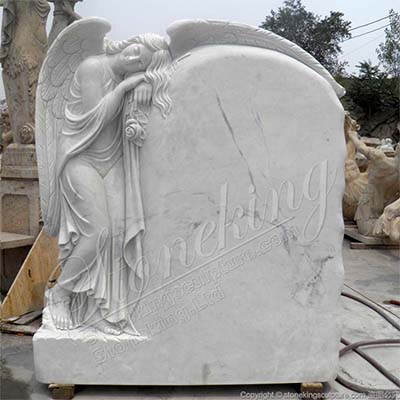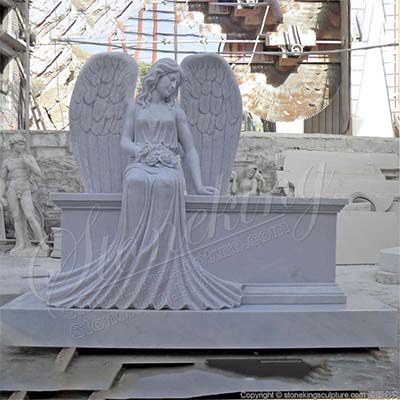Factory Price Handcrafted White Marble Headstone with Angel Statue for Grave for sale
This exquisite white marble headstone features a graceful standing angel statue, combining elegance and durability. Handcrafted from high quality white marble, this headstone offers both beauty and durability, making it a perfect memorial choice and a timeless tribute.
Size: Customized Size
Material: Solid White Marble
Usage: Outdoor
Advantage: Wholesale price offered
Hand carved with care and attention to detail, this white marble headstone with a graceful angel statue standing aside serves as a symbol of love, peace and remembrance. The angel's face embodies serenity and compassion, offering comfort to those who visit and providing a sense of peace during difficult times. Angels are often seen as messengers of hope and guardians of souls, making this particular design a powerful tribute to our loved ones.
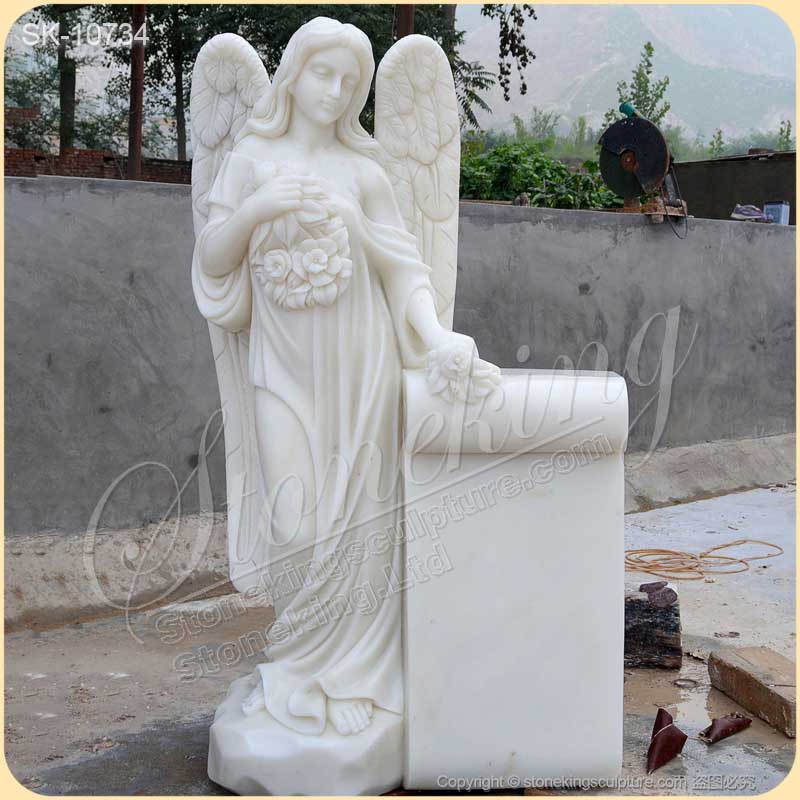
This white marble headstone is made from high quality materials that ensure both durability and elegance, making it an ideal choice for memorials. The natural veining and sheen of white marble create a stunning aesthetic that stands out in any cemetery or memorial garden. And, our white marble headstone offers various customization options, allowing you to inscribe a name, date and meaning message that captures the essence of your loved one. Whether for a simple inscription or a more elaborate design, our artisans is dedicated to helping you to create a tribute that truly reflects their unique spirit.
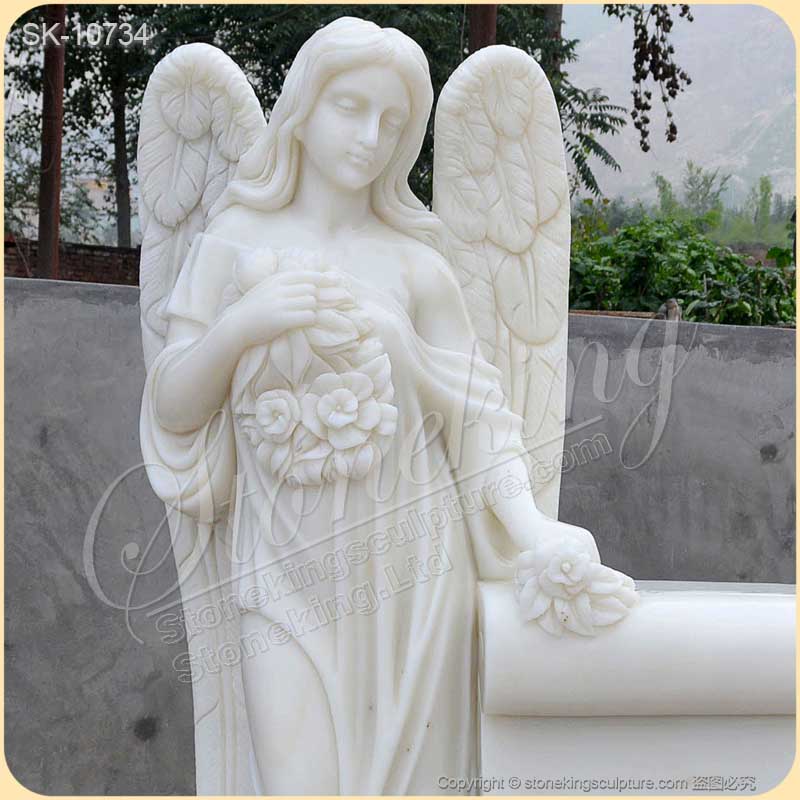
Whether placed in a cemetery, a memorial park, or a family garden, this white marble headstone with angel statue seamlessly fits into any setting. Its elegance design enhances the beauty of its surroundings while providing a peaceful space for family and friends to remember their loved one. For more information or to customized your headstone, please reach out to our dedicated team, and we are here to help you create a meaningful memorial that will be cherished forever.
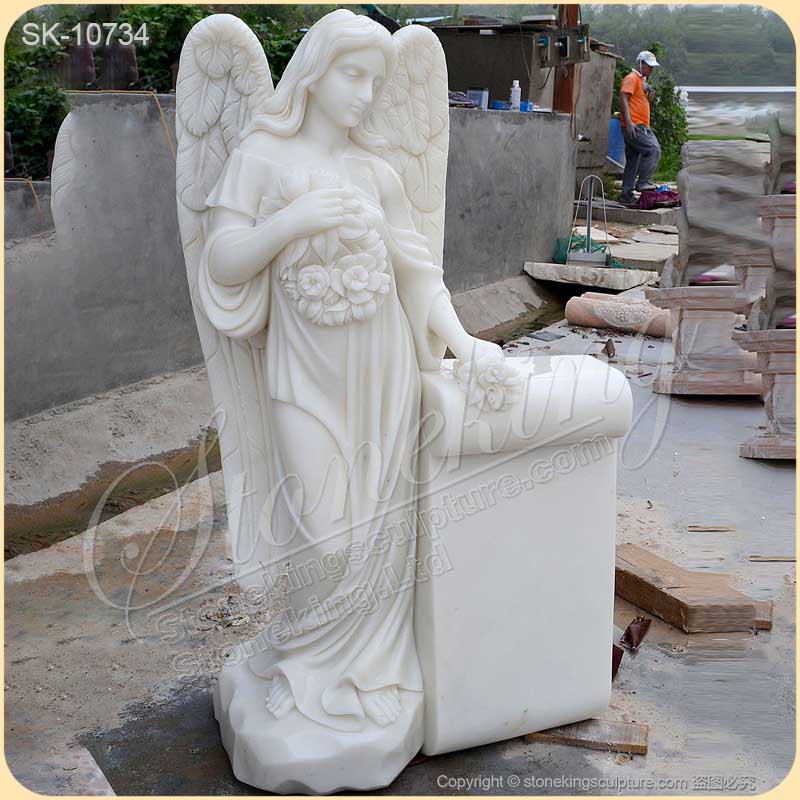
Table of Content
How Long Will a Marble Headstone Last?
What Is the Difference Between Marble and Other Types of Headstones?
How Much Does a Marble Headstone Typically Cost?
How do I Clean and Maintain a Marble Headstone?
Can Marble Headstones be Customized?
What are the Benefits of Choosing a Marble Headstone?
What Sizes and Styles are Available for Marble Headstone?
Do Marble Headstones Withstand Weather Conditions?
Historical and Cultural Significance of the Marble Headstones
What Is a Marble Headstone?
A marble headstone is a type of grave marker made from marble, a durable and elegant stone known for its beauty and durability. It can also be called marble tombstone, marble gravestone, marble grave marker, memorial stone, or marble monument. Commonly used for cemeteries, marble headstones serve as a memorial for the deceased, providing a physical representation of their life and a place for loved ones to visit and remember. Marble headstones are often chosen for their aesthetic appeal, providing a timeless look that can enhance the cemetery landscape. They come in various colors, with white being the most popular, symbolizing purity and peace.
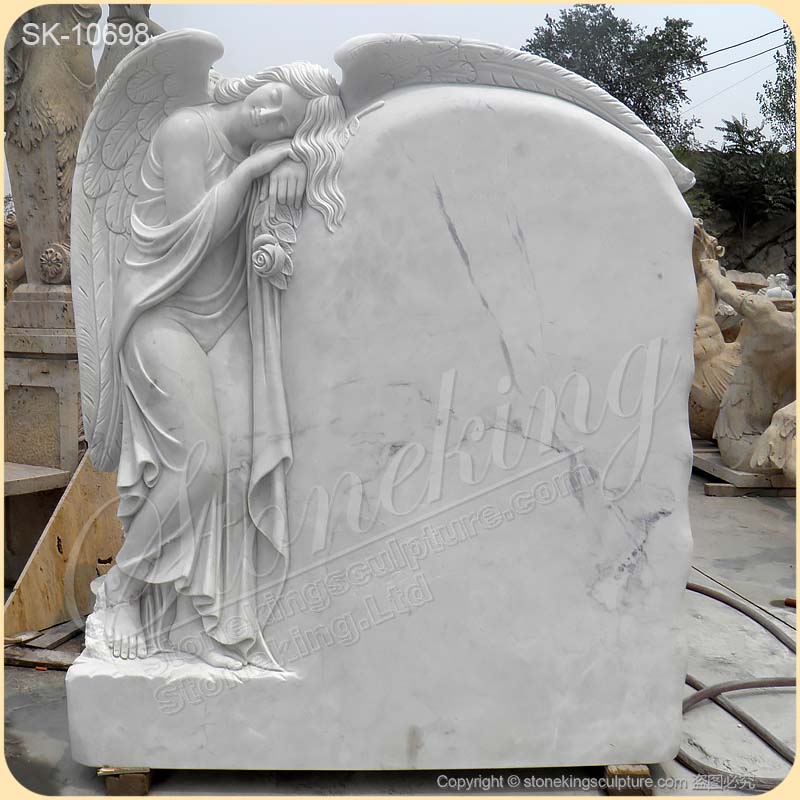
Marble headstones come in a variety of colors, including white, grey, black, beige, and even pink or green, allowing for range of styles to match the preferences of the deceased's family. Its natural veining patterns add uniqueness to each headstone. Families can engrave names, dates, epitaphs, and even images or symbols that reflect the deceased's personality or beliefs. The intricate designs available can range from simple to elaborate, allowing to personal expression.
Marble headstones are resistant to weathering, making them a suitable choice for outdoor use. With proper care and maintenance, they can last for decades or even centuries, preserving the memory of loved ones. And, marble headstones have historically been symbols of virtue and permanence in many cultures, and they have been used for centuries in monumental architectural and memorials, signifying its longstanding tradition and elegance. In many cultures, marble symbolizes purity and eternal life, making it a meaningful choice for a headstone.
Is Marble Good for Headstone?
Aesthetic Appeal
Marble is renowned for its elegant appearance, characterized by its smooth surface and natural veining. It comes in a variety of colors and patterns, including white, grey, pink, yellow, beige and black, and the natural veining patterns in marble will create a unique look for each headstone, making it a special tribute to the deceased and enhancing the beauty of a gravesite.
The natural beauty of marble makes it a fitting choice for commemorating loved ones. Its classic appearance is often associated with memorials, reflecting the solemnity and significance of the occasion. This aesthetic quality makes marble a favored choice for families looking to create a timeless tribute.
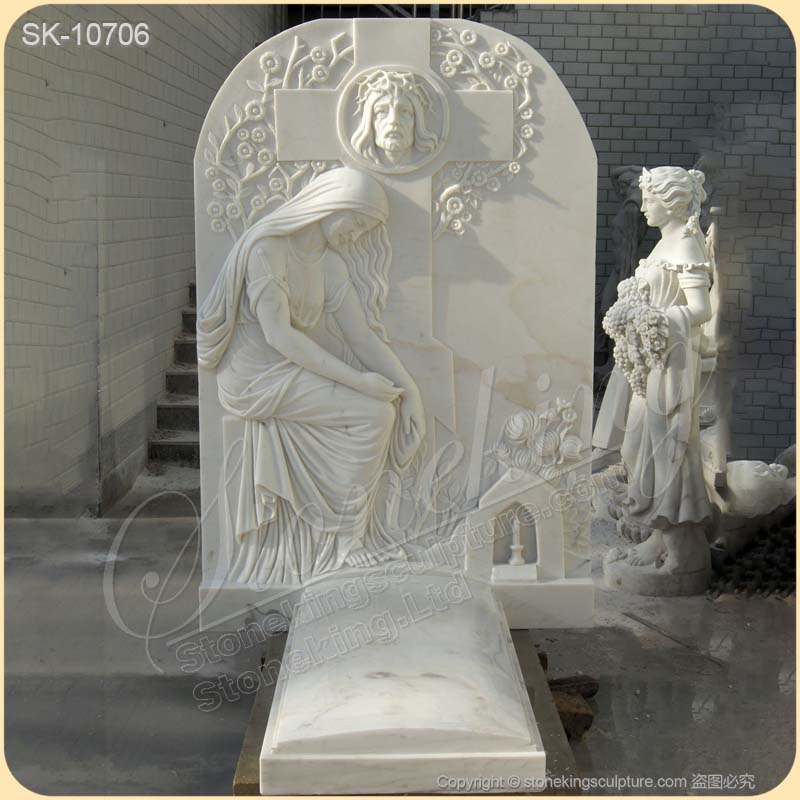
Durability and Longevity
Marble is a metamorphic rock that is relatively hard and dense. While marble is not as hard as granite, it is a still durable material. It can withstand various environmental conditions, including moisture, temperature changes and sunlight. Compared to granite, marble may be more susceptible for scratching and staining, and it will wear down due to weathering, especially in harsh climates. With proper care and maintenance, marble headstones can last for decades, preserving its appearance and integrity over time.
Cultural and Historical Significance
Marble has been used for centuries in memorials, monuments, sculptures and buildings, reflecting its historical importance in various cultures. Ancient Greeks and Romans often use marble for their temples and monuments, associating the material with immortality and the divine. This cultural significance enhances the choice of marble for headstones, as it embodies a sense of reverence and respect for the people who died. In many traditions, marble symbolizes purity and eternity, making it a fitting material for honoring the deceased, and marble has a long history in monument-making, often seen in historic cemeteries and notable memories. In contemporary society, marble headstones continue to be a symbol of honor and memory. They are often seen in historic cemeteries, adding a sense of continuity to the way we remember and celebrate lives lived.
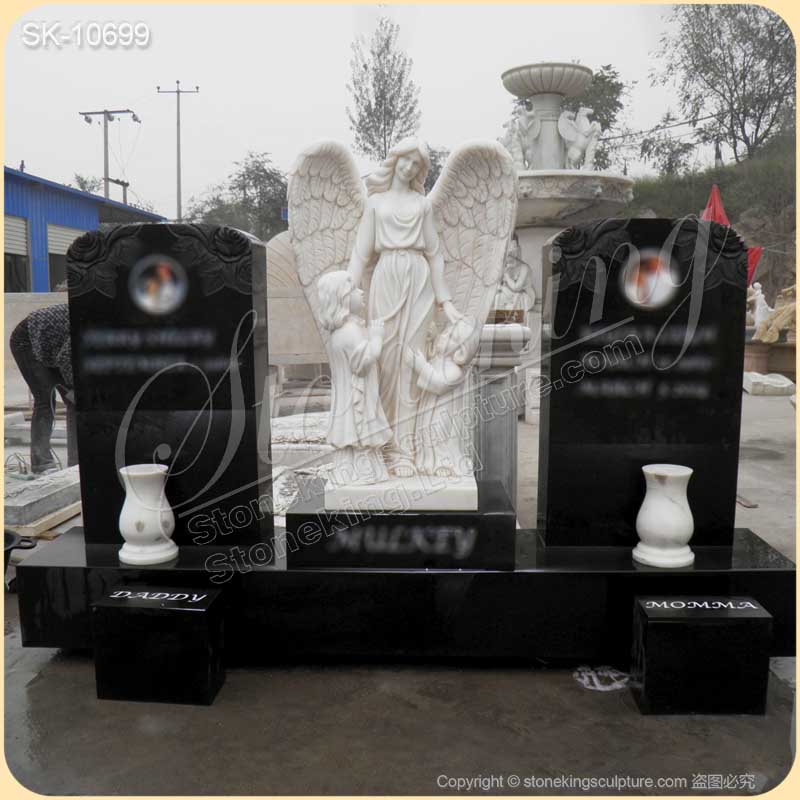
Customization Options
Marble headstones can be easily carved and engraved, allowing for a high degree of customization. Various design elements such as shape, size and style can be customized, and different marble colors and finishes could be bespoke, allowing for unique aesthetics. Engravings can feature names, dates, epitaphs or religious symbols or portraits, creating a personalized tribute to the deceased. Families can choose various shapes, sizes and engravings, allowing for a personal touch that captures the essence of the individual being memorized.
Low Maintenance
Maintaining a marble headstone requires occasional cleaning and care, such as gentle cleaning with soft, non-abrasive materials to prevent scratches. It is advisable to use a mixture of water and mild soap for regular upkeep. Avoid harsh chemicals that could damage the marble, and avoid abrasive cleaners to scrubbing pads, as they can damage the surface. Additionally, sealing the marble can help protect it from moisture and staining, extending its lifespan. Regularly inspect the headstone for any cracks, chips or discoloration, and address repairs promptly.
Environmental Impact
Marble is natural stone, making it an environmentally friendly option in comparison to synthetic materials. Marble is known for its durability, which means that it can last for many decades or even centuries with minimal maintenance. This longevity can offset some environmental impacts over time, as fewer replacements may be needed.
Symbolic Value
Marble is often associated with purity, strength and permanence. For many, choosing a marble headstone can carry symbolic significance, reflecting the enduring love and memory of the deceased. This emotional connection can provide comfort to grieving families, as marble headstones serve as lasting memorials that honor their loved ones' lives. They are a popular choice for those looking to create a meaningful and lasting tribute to their loved ones.
How Long Will a Marble Headstone Last?
Generally, marble headstones can last for several decades to over centuries, depending various factors such as the quality of the marble, the environmental conditions and the level of maintenance. Marble headstones can withstand rain and sun exposure, but extreme weather conditions, like freezing temperatures or acid rain, may lead to wear and erosion compared to granite. So, regular maintenance, including cleaning and sealing, can help prolong the longevity of the stone.
Marble headstones are particularly affected by environmental factors such as humidity, acid rain, and temperature fluctuations. Areas with high pollution levels or acidic rain can accelerate the deterioration of marble, leading to shorter lifespans. In contrast, regions with stable weather conditions and lower pollution levels can allow marble to endure longer.
High quality marble tends to be more durable and resistant to weathering than lower-quality alternatives. The mineral composition and structural integrity of the marble directly influence its ability to withstand weathering and wear over time. In addition, regular maintenance is essential for extending the life of marble headstones. Cleaning stone surfaces and resealing them when necessary can help prevent growth of lichens and biological stains that may cause damage. Implementing proper care can preserve the aesthetic and structural qualities of marble, ensuring it remains intact for a more extended period.
What Is the Difference Between Marble and Other Types of Headstones?
Marble Headstones
Marble is renowned for its beauty and elegance. Its smooth, polished surface can be intricately carved, allowing for detailed inscriptions and artistic designs. The natural veining of marble provides a unique appearance, making each headstone distinctive. While marble is a strong material, it is softer than granite and can be susceptible to weathering over time. It is prone to scratching and may show wear in harsh environments, especially in areas with extreme weather conditions.
Marble requires regular maintenance to preserve its appearance. It can stain easily, particularly from elements like moss, lichens or pollution. Marble headstones require periodic cleaning and sealing to protect against stains and fading. Its susceptibility to scratches and chips means it may need repairs over time. The prices of marble headstones can vary significantly based on quality, size and design complexity. They tend to be a more affordable option among high-end materials.
Granite Headstones
Granite is one of the most durable materials for headstones, highly resistant to weathering, scratching fading and chipping, making it an excellent choice for outdoor settings. It can withstand harsh environmental conditions, making it an ideal choice for long-term preservation. Available in a wide range of colors and finishes, granite monument offers numerous aesthetic options. Its ability to withstand the elements means it will maintain its appearance longer than marble.
Granite requires less maintenance compared to marble. It is less prone to staining and generally only needs occasional cleaning to remove dirt or debris. Its resilience against the elements means it tends to maintain its appearance over time without the need for extensive care. Granite memorials provide better value for those looking for durability and longevity in their memories, making them a worthwhile investment in the long run.
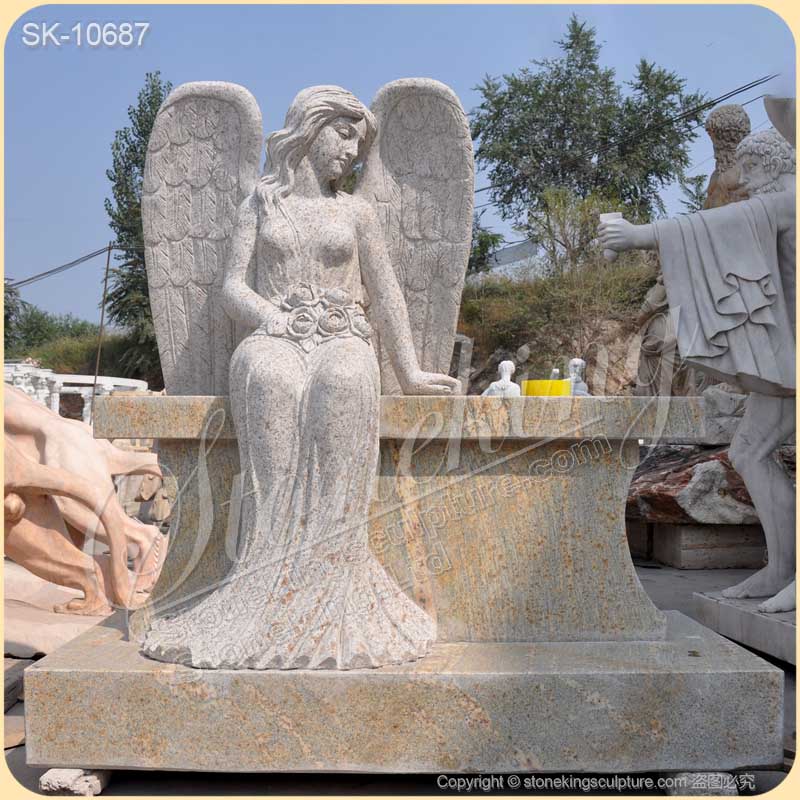
Limestone Headstones
Limestone has a softer, more natural look, often featuring earthy, more muted colors. Its natural texture can give a unique look that differs from polished marble or granite. It can be easily carved, allowing for personalized designs, though it may not have the same polished finish as marble or granite. Limestone headstones are softer than both marble and granite, making them more vulnerable to erosion and wear from environmental factors. Over time, they can become damages, especially in harsh weather conditions.
Limestone headstones require regular maintenance to prevent deterioration. They may need cleaning and protection against moisture, which can lea to more extensive repairs if neglected. Limestone headstones are less expensive then both granite and marble, making them a budget-friendly option.
Bronze Headstones
Bronze headstones can provide a classic and elegant look, often used in combination with granite or marble bases. They can be intricately detailed and offer a timeless appeal. Bronze is highly resistant to corrosion, weathering and decay, making it a durable option. While bronze is durable, it can develop a patina over time, which some people appreciate for its vintage look, while others may prefer to clean it periodically to maintain its shine.
Bronze offers a different aesthetic with its rich, warm tones, and it can be cast into various shapes and designs, making it highly customizable. Bronze headstones require periodic cleaning to remove oxidation, but is it generally low-maintenance. Bronze headstones can be comparable to granite in price, often making them a premium choice.
Sandstone Headstones
Sandstone is prized for its natural beauty and unique coloration, which can range from light beige and yellow to deep reds and browns. Its layered structure often gives it a striking visual appeal, and it can carved into intricate designs or left with a more rustic, natural finish. Sandstone headstones are more softer and more porous than granite and marble, making them more susceptible to erosion and damage from the elements.
While they can withstand normal weather conditions, exposure to rain, snow and extreme temperatures may lead to weathering over time. This means sandstone headstones may require more frequent maintenance and care compared to harder stone materials. Generally, sandstone headstones tend to more affordable, and they can still be considered a mid-range option. Its price point makes it accessible for families looking for a beautiful yet budget-conscious memorial.
Wooden Headstones
Typically crafted from durable hardwoods such as oak, maple, cherry or cedar, wooden headstones can be designed to reflect the personality and values of the deceased. Artisans may use techniques like carving, engraving, or painting to personalize the headstone, incorporating symbols, quotes or images the celebrate the individual's life. Wooden headstones offer a natural, eco-friendly alternative to traditional stone memorials.
Wooden headstones can blend harmoniously into natural settings, enhancing the beauty of a cemetery or memorial garden. While wood is generally less durable than stone, high-quality hardwoods can withstand elements for many years, especially when treated with weather-resistant finishes. Regular maintenance, such as cleaning and resealing, can help preserve the appearance and integrity of the headstone.
Slate Headstones
Slate is highly durable and can withstand weather conditions without significant degradation. Its ability to resist chipping and cracking makes it a reliable choice for long-lasting memorials. Slate headstones are available in various colors, typically grey, black or green, offering a unique and elegant appearance. Its smooth finish can be polished for a refined look or left rough for a more rustic feel, allowing for personalized styles.
In some cultures, slate symbolizes permanence and resilience, adding a layer of meaning to its use as a headstone material. Slate headstones require minimal maintenance. Regular cleaning with mild soap and water is usually sufficient to keep them looking their best. They are generally affordable, so slate headstones are a cost-effective choice for many families.
How Much Does a Marble Headstone Typically Cost?
The cost of a marble headstone can vary widely based on several factors, including material quality, size, complexity of design, the intricacy of engravings and additional customization options. Simple and smaller headstones typically cost less, while large and more elaborate designs substantially increase the final price. Generally, the price can range from approximately USD1000 for a basic design to USD5000 or higher for more sophisticated options or large monuments.
The quality of marble can greatly influence the price. High-grade marble, known for its aesthetic appeal and durability, is more expensive than lower-quality options. Additionally, some marbles come from specific regions known for their unique colors and patterns, which can also drive up costs. The size of the headstone is a primary factor in determining cost. Large headstones require more materials and labor, leading to higher prices, and design complexity, including additional features such as carved images, intricate patterns, or personalized elements, will also add to the overall cost.
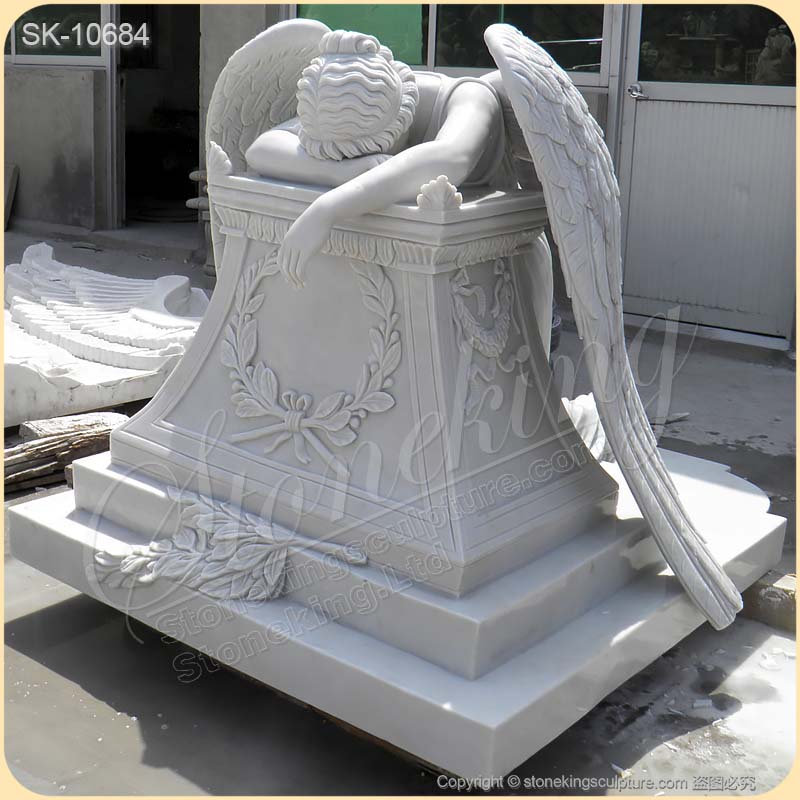
Basic engravings often come at a lower cost, while intricate designs, detailed artwork or personalized inscriptions can increase the price significantly. Custom designs, which may include symbols, portraits, or unique fonts, will typically be more expensive than standard engravings. Additional features such as vases, bronze plaques or decorative bases can also add to the overall expense.
How do I Clean and Maintain a Marble Headstone?
To clean a marble headstone, start by removing any loose dirt, leaves, or debris from the headstone. Use a soft-bristle brush to gently sweep the surface, paying special attention to crevices. For further cleaning, please mix a small amount of mild soap with warm water. If using a marble cleaner, please follow the instructions for dilution. Avoid acidic or abrasive cleaners, as these can damage the marble.
Dampen the sponge or a soft cloth in the soapy water, gently apply it to the marble surface, and use soft, circular motions to clean the headstone without scratching the surface. Focus on stained areas or engravings, but be careful not to apply too much pressure. After scrubbing, rinse the area with clean water to remove any soap residue, as soap left on the marble can lead to a dull appearance. Finally, use a soft cloth or towel to gently pat the headstone dry. Avoid air drying, as moisture can lead to mold or mildew growth.
For tough statins, you can use a plastic scraper to gently lift the stain, followed by reapplying the soapy solution. If necessary, use a paste made from baking soda and water, applying it to the stain, allowing it to sit for a few minutes, then rinsing thoroughly.
For regular maintenance, please inspect the headstone regularly for signs of damage, such as cracks or chips. Promptly addressing these issues can prevent further deterioration. Keep flowers or decorations in pots rather than directly on the headstone to avoid moisture retention that can cause staining. Steer clear of bleach, vinegar or any acidic cleaners, as they can damage the marble.
Can Marble Headstones be Customized?
Marble headstones offer various customization options that cater to personal tastes and commemorative wishes of the deceased's family. This customization can include designs, inscriptions, shapes, and additional elements that contribute to a unique memorial. While marble is a classic choice, you can also explore different types of stone, such as granite or sandstone. Marble comes in various colors, from pure white to darker hues, each offering a distinct aesthetic. For the surface finish, choices ranges from polished to honed finishes, affecting the stone's appearance and texture.
The shape and size of the marble headstones could be bespoke to allow for personalization and fit specific preferences. Common shapes include flat markers which are simple, low-profile stones set flush with the ground, upright headstones that stand vertically and can be more elaborate, bevel markers that slightly raised, combing aspects of flat and upright stones and custom shapes that can be tailored to designs like hearts, angels or other motifs upon request. Sizes can vary widely, accommodating different plots and personal preferences.
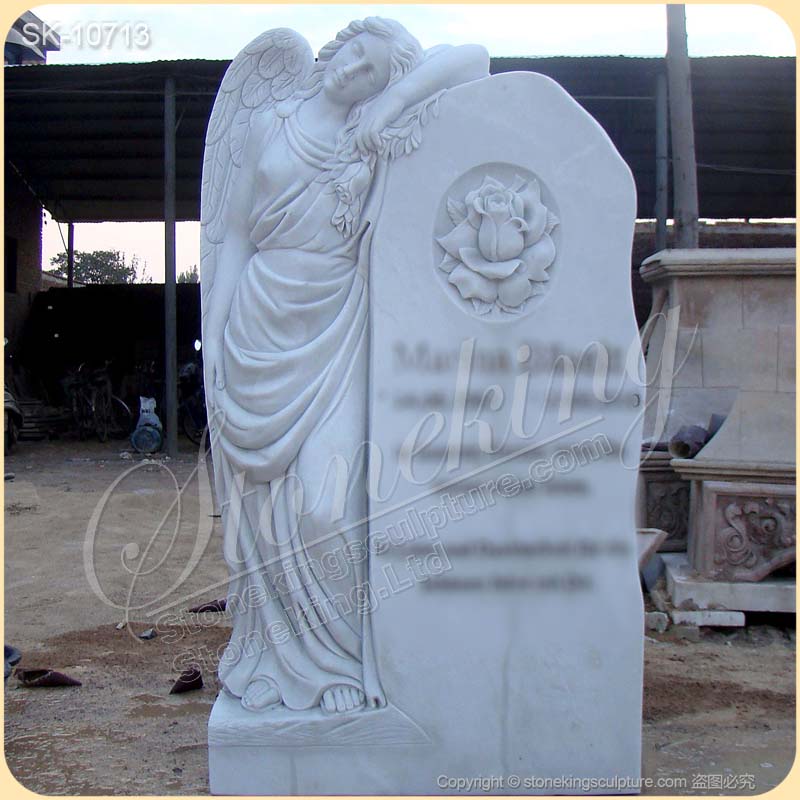
Engravings are a significant aspect of headstone customization. Families can choose names, dates, epitaphs and personal messages to reflect the decease's beliefs for personality, and meaningful quotes or phrases that encapsulate the essence of their love one. A variety of fonts can be used, from traditional serif styles to more modern sans-serif designs. Some may also include images or symbols that hold particular significance, such as religious icons or hobbies. Beyond text, families can incorporate intricate designs, such as floral patterns, religious motifs, or artistic elements that represent nature or spirituality. This adds a unique touch that reflects the individual's life story.
Beyond basic customizations, families can include additional features to enhance the memorial, such as the engraved or etched photographs added to the gravestone, the vases holding flowers or other tributes, or the lighting features.
Combining materials can enhance the design. For instance, adding bronze plaques or glass elements can create a striking contrast against marble, making the headstone more visually appealing. Different cultures and religions have specific customs regarding headstone design. Customizations can respect these traditions, such as using specific symbols or adhering to layout guidelines. Families often find comfort in creating a memorial that truly represents their loved ones, so a customized headstone not only serves as a physical marker but also encapsulates memories, helping the surviving family members and friends to recall and celebrate the life of the deceased in a meaningful way.
What are the Benefits of Choosing a Marble Headstone?
Aesthetic Appeal
Marble headstones are renowned for their classic and elegant appearance. The natural veining and variety of colors-ranging from pure white to shades of gray, green, and even pink-offer a sophisticated look that can be customized to reflect the personality of the people who died. The polished finish enhances the stone's beauty, making it a striking presence in any cemetery or graveyard setting. Additionally, marble can be carved into intricate designs and personalized engravings, allowing for unique tributes to those who have passed away.
Durability and Longevity
Marble is renowned for its strength and longevity, and it can withstand harsh weather conditions, making it a reliable choice for headstones that will endure over time. With proper care and maintenance, a marble headstone can last for many decades, weathering various environmental conditions. Marble headstones are resistant to fading and can withstand the test of time, though it may require occasional cleaning to prevent buildup of dirt or staining. Proper sealing can also enhance its longevity, providing additional protection against the elements.
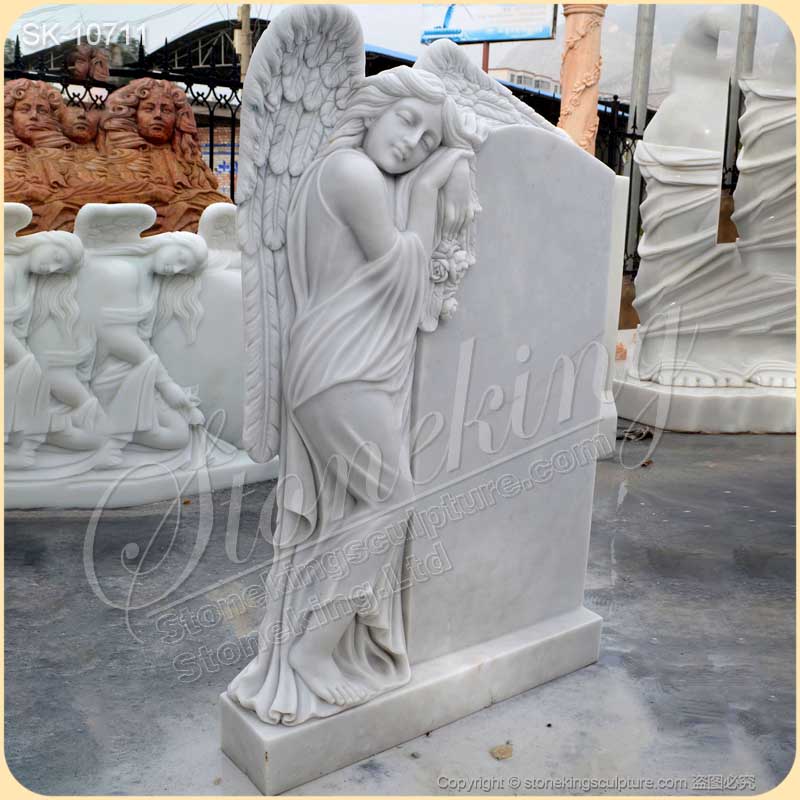
Historical Significance
Marble has been a favored material for memorials and monuments for centuries, dating back to ancient civilizations. Its use in historical landmarks and sculptures adds a layer of cultural significance, connecting modern memorial practices with traditions of honoring the deceased. This connection can provide a sense of continuity and respect for ancestral traditions.
Variety of Design Options
Marble headstones are available in various shapes, sizes and colors, allowing for personalized and custom designs. It can be shaped into different forms, such as flat markers, upright stones or elaborate monument, catering to individual tastes and cemetery regulations. Whether opting for simple engravings or intricate carvings, families can choose elements that resonate with their loved one's personality and legacy. This flexibility makes it possible to create a unique memorial that stands out while honoring a personal connection.
Ease of Maintenance
Maintaining a marble headstone can be relatively straightforward with regular cleaning and care. Unlike some materials that may require complex restoration processes, marble can be cleaned with gentle soap and water, maintaining its shine and appearance. This ease of upkeep makes it an appealing option for many families who wish to keep their loved ones' memorials looking their best.
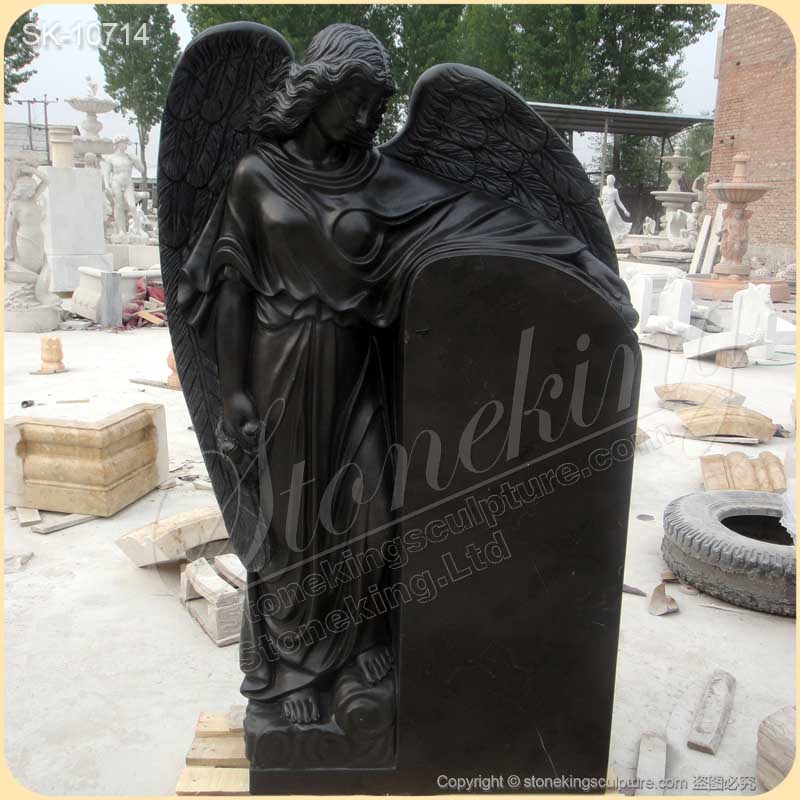
Personalization
Marble headstones offer numerous options for customization, as they can be easily carved or engraved, allowing families to include personal touches such as names, dates and meaningful symbols. Families can choose from various shapes, sizes and designs, as well as personal inscriptions, quotes or symbols that represent the deceased's life and passions. This level of personalization allows families to create a lasting tribute that reflects the individuality of the person remembered.
Symbolism
In many cultures, marble symbolizes purity and eternal life. Its association with the divine and the beautiful often makes it a fitting choice for commemorating loved ones. By choosing marble headstones, families can convey a sense of reverence and honor for the deceased, reflecting their belief in the ongoing connection between life and death.
What Sizes and Styles are Available for Marble Headstone?
Upright Headstones
Upright marble headstones are the most traditional and recognizable style. They stand vertically above the ground and can vary in various sizes and shapes, such as rounded tops, flat tops, or angled edges, and often include intricate carvings or engravings that reflect the deceased's life, beliefs or interests, making them a versatile option. Common designs include: standard upright headstone that feature a rectangular shape with a flat top, bevel top which is slightly slanted at the top, and love heart tombstone that symbolizes love.
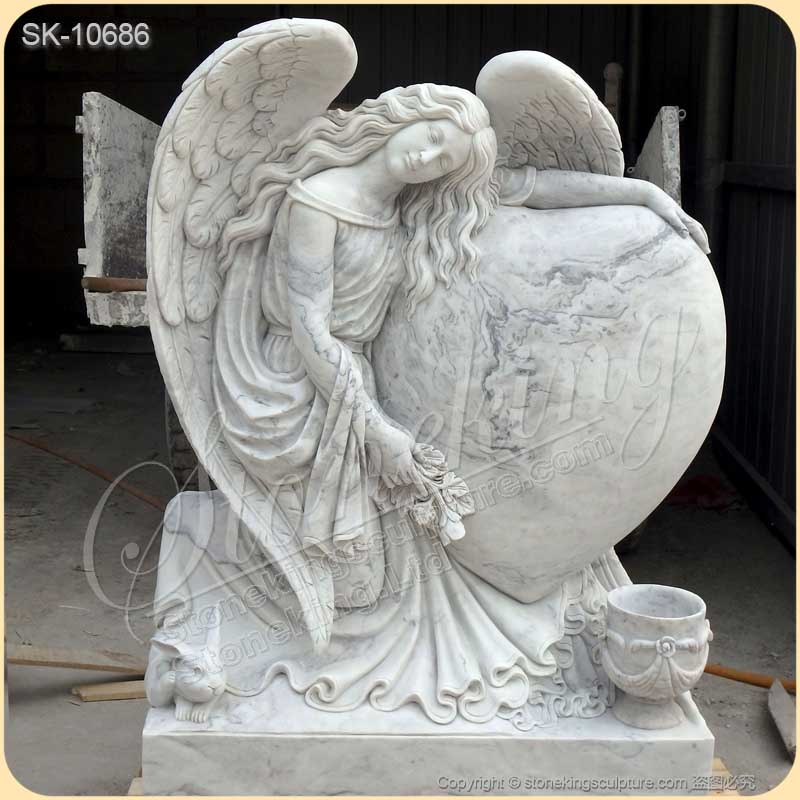
Flat Markers
Flat markers, also known as flat grave markers to grave plaques, are a popular option for commemorating loved ones in cemeteries. These markers lie flush with the ground, providing a subtle yet dignified way to memorialize individuals. They come in various shapes and sizes, featuring engraved inscriptions, symbols or decorative elements that honor the deceased. Flat markers can be less visible than upright headstones, especially in grassy or landscaped areas. Their simplicity allows for easy maintenance and is suitable for various cemetery regulations. Although flat markers can be customized, the design options may be more limited compared to upright stones.
Bevel Markers
Bevel headstones feature a sloped top and a thicker base, creating a unique profile that stands out among traditional flat makers. They have a sloped face that rises from the base to the top, offering a more three-dimensional appearance compared to flat markers. The angel of the bevel can vary, allowing for a range of aesthetic choice. Names, dates and custom designs can be engraved directly onto the stone or on plaques attached to the headstone.
Slant Markers
Slant headstones are characterized by their angled face, these markers provide a unique aesthetic that combines the simplicity of flat markers with the prominence of upright headstones. Slant markers have a vertical back with a sloped face, typically ranging from 16 to 18 inches in height at the back and tapering down toward the front. Slant markers are taller than bevel markers, typically standing inches off the ground, making inscriptions easier to read. The base of slant markers is often wider than the face, providing a stable foundation. The angel can vary, allowing for different visual effects and engraving styles.
Ledger Stones
Ledger stones, also known as flat or horizontal gravestones, lie flat on the ground, typically covering the burial plot or placed at the head of a grave. This design makes them less obtrusive and often easier to maintain. They come in various sizes but are generally rectangular, and the thickness can vary, with some being quite thick to withstand environmental wear. Ledger tombstones often feature inscriptions, including the deceased's name, date of birth and death, and epitaphs. Many ledger grave markers have a beveled edge or border, which can enhance their aesthetic appeal. Some may also have inset designs or decorations. They offer ample space for personalization, allowing families to express the individuality of the deceased through design and inscriptions.
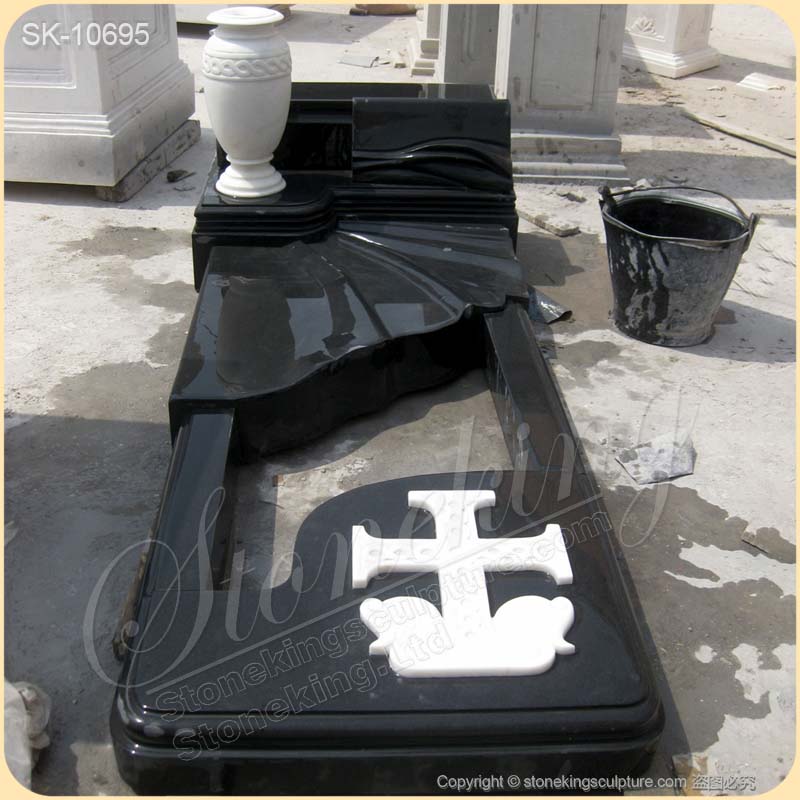
Obelisks
Obelisks are monumental structures characterized by their tall, four-sides, narrow tapering shape, which culminates in a pyramidal top. Originating from ancient Egypt, they have been adopted in various cultures and serve as a significant architectural and symbolic elements. They typically feature a square base the rises vertically, tapering as it ascends. The pyramidal apex symbolizes the rays of the sun, linking the obelisk to solar worship and the divine. Their height can vary significantly, from small garden obelisks to towering monuments that reach impressive heights.
Many obelisks are adorned with hieroglyphics, inscriptions, or relief carvings that commemorate significant events, rulers or deities. These inscriptions often convey messages of power, victory and devotion, serving as historical records. Obelisks symbolize strength, endurance and the connection between earth and the heavens. While primarily associated with ancient Egypt, obelisks have been adopted in various cultures, including Roman, Greek and contemporary societies. They are typically placed in prominent locations, such as plazas, parks or near significant buildings.
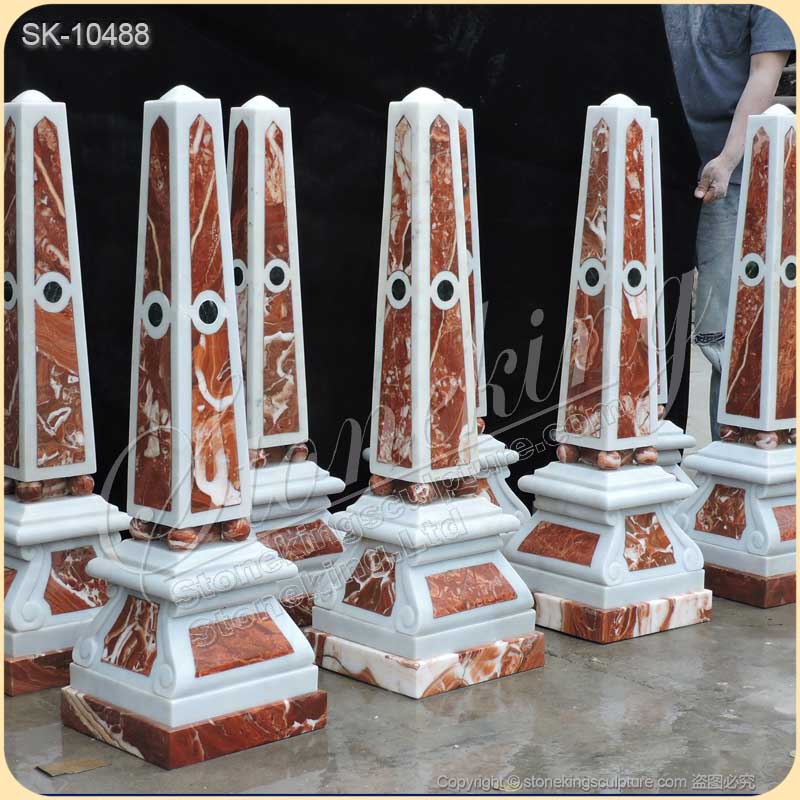
Cross Headstones
Cross headstones are a popular choice for memorials, symbolizing faith and the eternal connection to spirituality. They are characterized by their distinctive cross shape, which can vary in style, from simple and traditional to elaborate and ornate. They may feature a Latin cross, Celtic cross, or even a contemporary design, reflecting the individual's or family's faith. Many cross headstones incorporate additional symbols that hold personal or religious significance, including angels, doves, flowers, or even religious icons that represent the deceased's faith and values. Cross tombstones come in various sizes, from small markers to large monuments.
Cross gravestones hold deep cultural and religious meaning, particularly within Christianity, symbolizing Christ's sacrifice and the promise of eternal life. They can serve as a powerful reminder of faith for both the deceased and visitors. Cross headstones are typically placed in cemeteries, memorial gardens or family plots. Proper installation is crucial, often requiring a solid foundation to ensure stability.
Bench Markers
Bench marker gravestones, also knowns as bench markers or memorial benches, are unique in that they combine the functions of a gravestone and a seating area. Unlike traditional gravestones, bench markers provide a place to sit, offering a space to rest while remembering loved ones. They often have a flat or slightly sloped surface for inscriptions, allowing for personalization. They design can vary, with some featuring decorative elements like carvings or etchings. They can enhance the beauty of a cemetery or memorial garden, serving as both a tribute and a functional piece of landscape architecture.
Companion Headstones
Companion headstones are designed to commemorate two individuals, often couples or close family members, offer a range of features that cater to both aesthetic and functional needs. They typically feature a cohesive design that symbolizes the bond between the two individuals. This can share motifs, shapes, or inscriptions that highlight their relationship, such as intertwined hearts or matching symbols.
These headstones come in various sizes and shapes to suit different preferences and cemetery regulations. Many companion headstones can incorporate custom artwork or symbols that reflect the personalities and beliefs of the individuals. This could include religious symbols, nature motifs, or even personal hobbies, making each headstone unique. Companion headstones can be designed with integrated bases or surrounding features, such as flower vases or decorative borders.
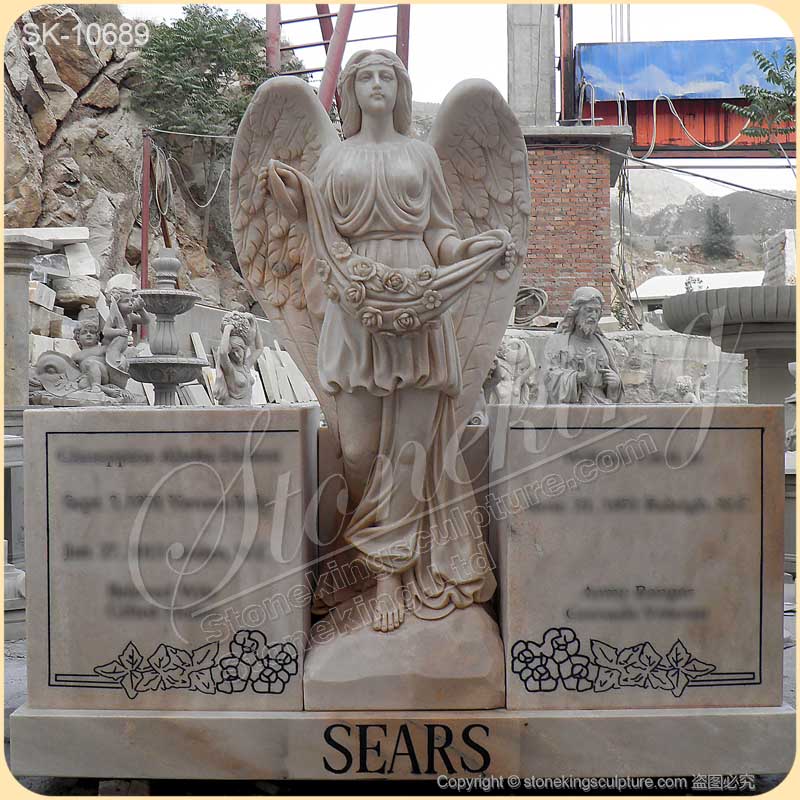
Angel and Figure Sculptures
For those looking for a more artistic expression, marble headstones can feature sculptural elements, such as angels, cherubs or religious figures, transforming a simple gravestone into a work of art that conveys deep emotion and reverence. Angles are often seen as messengers or guardians in various cultures and religious. Incorporating angelic figures into headstones can symbolize protection, comfort and soul's journey after death. Sculptural elements can also represent personal beliefs, with figures such as doves or crosses embodying themes of peace and faith.
These headstones come in various styles and configurations, from elegant, simples angels to intricate, multi-figure sculptures, and some may feature bas-relief designs. They offer a unique and meaningful way to commemorate loved ones, blending artistry with personal significance. The mourning angel gravestone is a famous work art, and the common styles include the standing angel monument and sitting angel memorialseries.
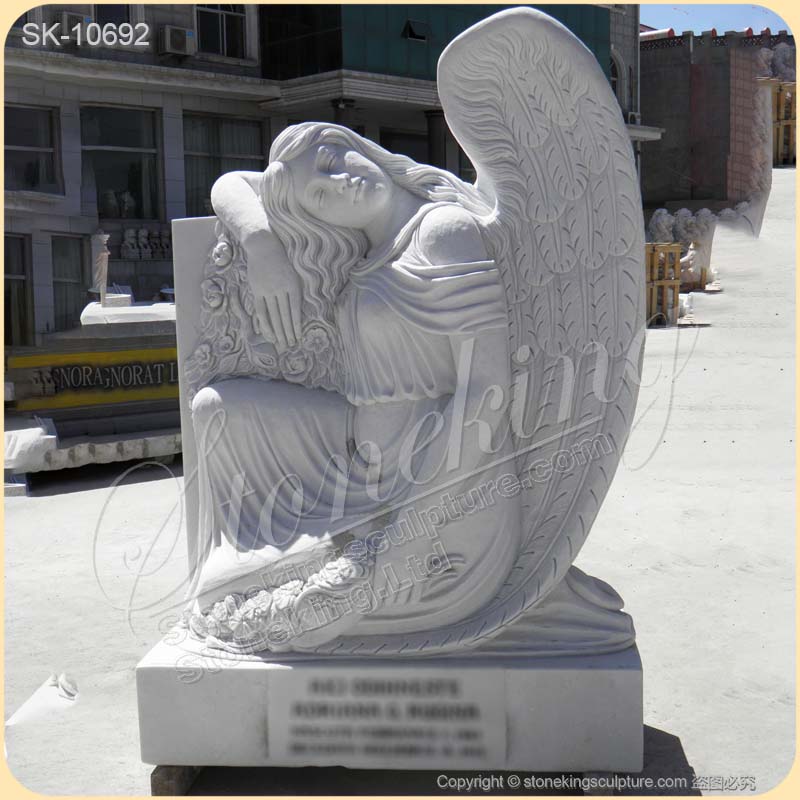
Custom Designs
Custom design headstones offer a unique way to honor and memorize loved ones, reflecting their personality, values and life story. Each headstone can be tailored to meet individual preferences, ensuring a lasting tribute. From traditional upright stones to flat markers and even intricate sculptures, the style of a headstone can be customized to suit personal tastes. Options can include engrave images, motifs, and religious symbols, allowing families to create a special design.
Families can incorporate names, dates, meaningful quotes, or even photographs to create a meaningful headstone. Custom granite markers can range from heart shapes to more elaborate designs like books, crosses, or even symbols that represent interests such as fishing or gardening. It will add a distinctive aesthetic appeal to the burial site.
Do Marble Headstones Withstand Weather Conditions?
Marble headstones have been a popular choice for memorialization for centuries due to their aesthetic appeal and perceived durability. Marble is a metamorphic rock primarily composed of calcite, demonstrates a degree of resilience against weathering. Despite this, its longevity is compromised by environmental factors including moisture and temperature fluctuations, which can lead to deterioration over time.
One of the primary challenges facing marble headstones is their susceptibility to weathering. In areas prone to high winds, debris can cause physical damage to marble headstones. Sand, dirt and small stones can scratch the surface, while larger objects can chip or crack the stone. Marble can react with acidic substances, including acid rain, which can erode the surface over time. Another factor affects headstones is moisture. In moderate climates, marble can withstand moisture reasonably well; however, in areas with high humidity or frequent rainfall, water can lead to staining and the growth of mold or algae, which can affect the stone's appearance. Regions that experience harsh winters with freeze-thaw cycles pose a significant threat to marble headstones. As water enters cracks and pores in the marble, it expands when frozen, which can exacerbate any existing weakness.
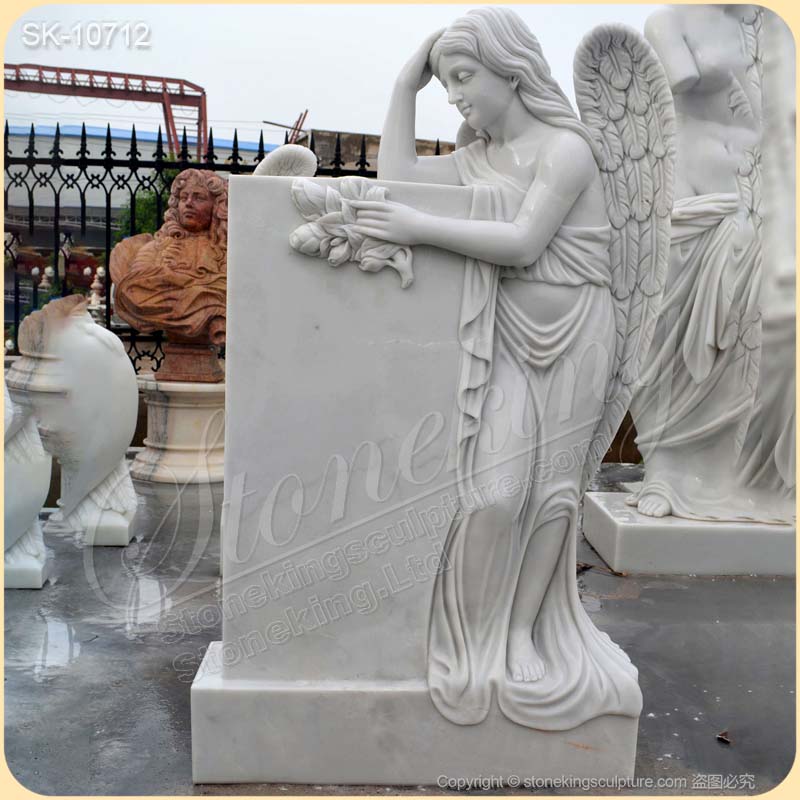
To enhance the longevity of marble headstones in challenging weather conditions, regular maintenance is essential. Cleaning the stone with mild soap and water can help remove dirt and organic growth, while applying a protective sealant can create a barrier against moisture and pollutants.
Historical and Cultural Significance of the Marble Headstones
Marble headstones have a rich history, rooted in ancient traditions and cultural practices. In ancient Greece and Rome, marble was commonly used for tombstones and monuments. The Greeks often inscribed epitaphs on marble slabs, reflecting a person's status and achievements. Roman adopted this practice, often engraving epitaphs that conveyed personal narratives.
In the middle ages, marble headstones became more prominent in Christian contexts, symbolizing resurrection and eternal life. The Renaissance revived classical influences, leading to ornate designs that reflect humanistic values and the importance of individual legacy. In various cultures, such as in Islamic traditions, beautifully carved marble headstones often feature calligraphy and floral motifs that honor the deceased and reflect spiritual beliefs.
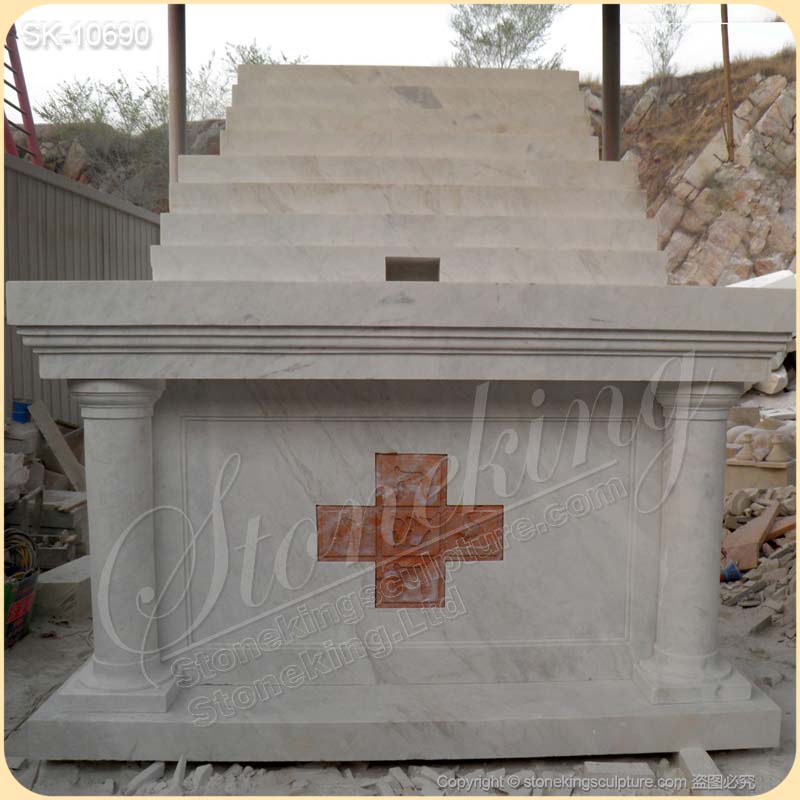
In the 19th century, the rise of cemetery movement in Europe and North America led to the establishment of landscaped burial grounds where marble headstones became symbols of status and familial pride. These headstones often showcased artistic craftsmanship, with styles ranging from simple and understated to elaborate and decorative tombstones. Today, many view marble gravestones as a connection to tradition, a lasting tribute to loved ones, and a reminder of the shared human experience of grief and remembrance.
Marble headstones represent permanence and remembrance, and cultures worldwide view them as a lasting tribute to the deceased, symbolizing respect and continuity of memory. Marble allows for detailed carvings and inscriptions, providing a means for families to express their grief and commemorate their loved ones. Symbols, motifs and epitaphs convey personal stories and cultural beliefs. In many cultures, the act of visiting and maintaining a marble headstone is an important ritual. It fosters a connection between the living and the deceased, reinforcing cultural beliefs about life, death and the afterlife.
nstead of white marble, there are various types of stone and marble materials for the white marble headstone, such as black marble, yellow marble, granite or bronze materials. Inscriptions, etchings, letterings or ceramic photos could be added on the headstone to make the statue a more personal tribute. The sizes could be customized to suite the intended location or space. Contact with us freely for any ideas and we would like to complete the headstones to add the unique touch.







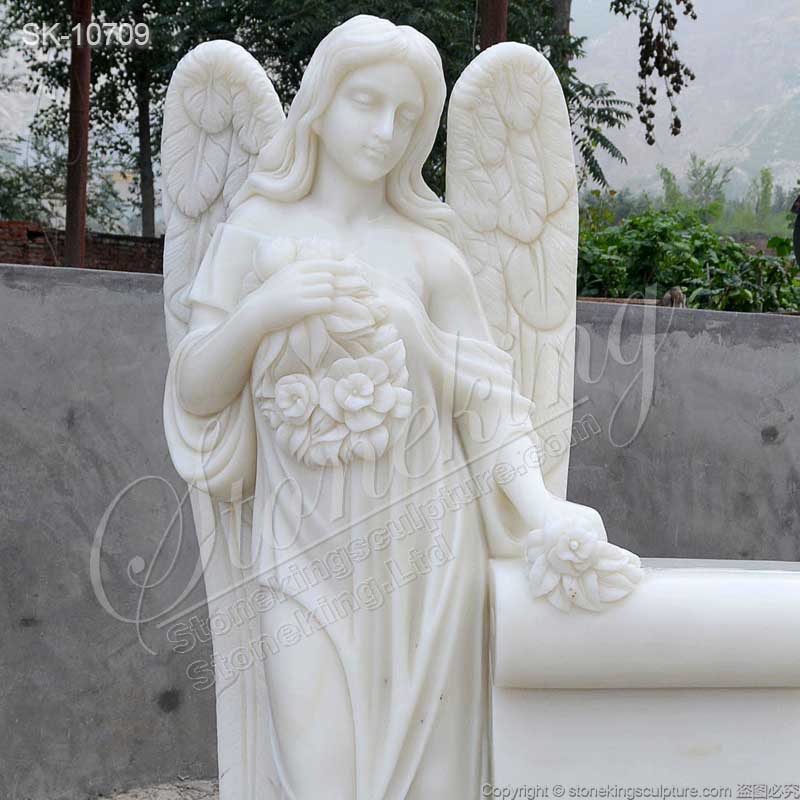
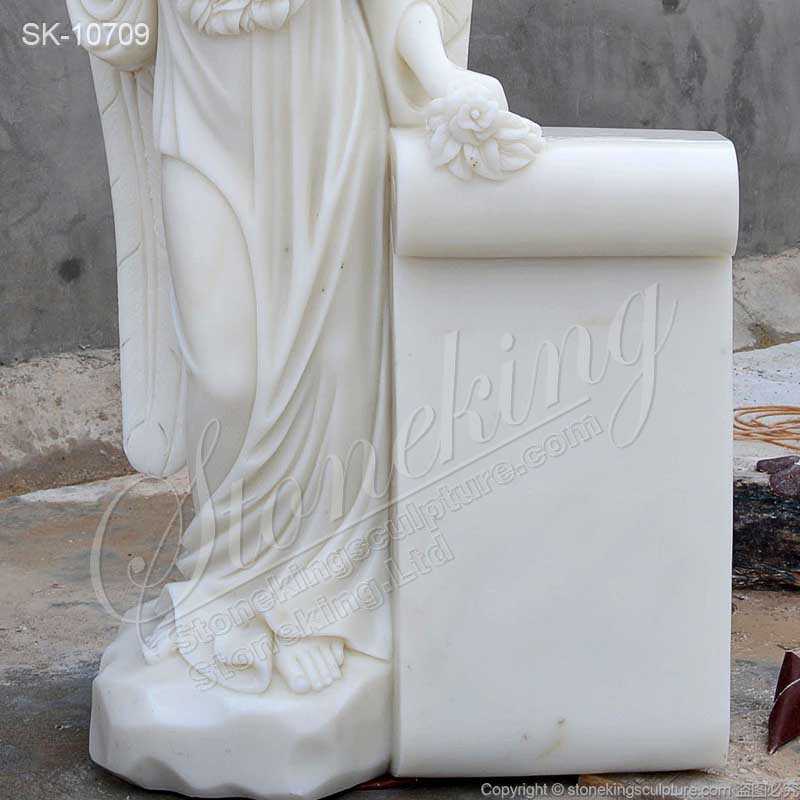
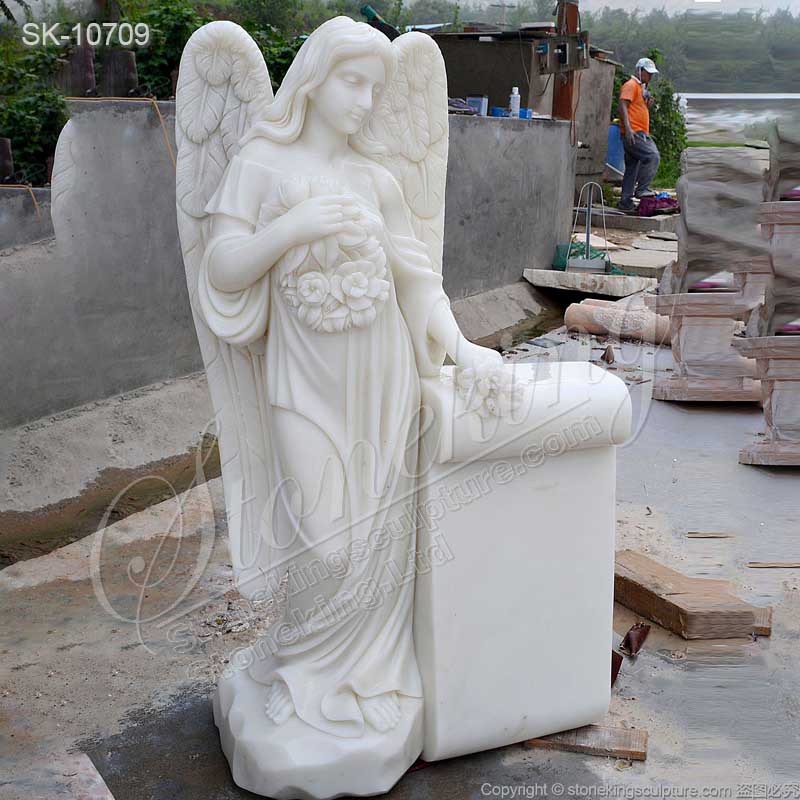
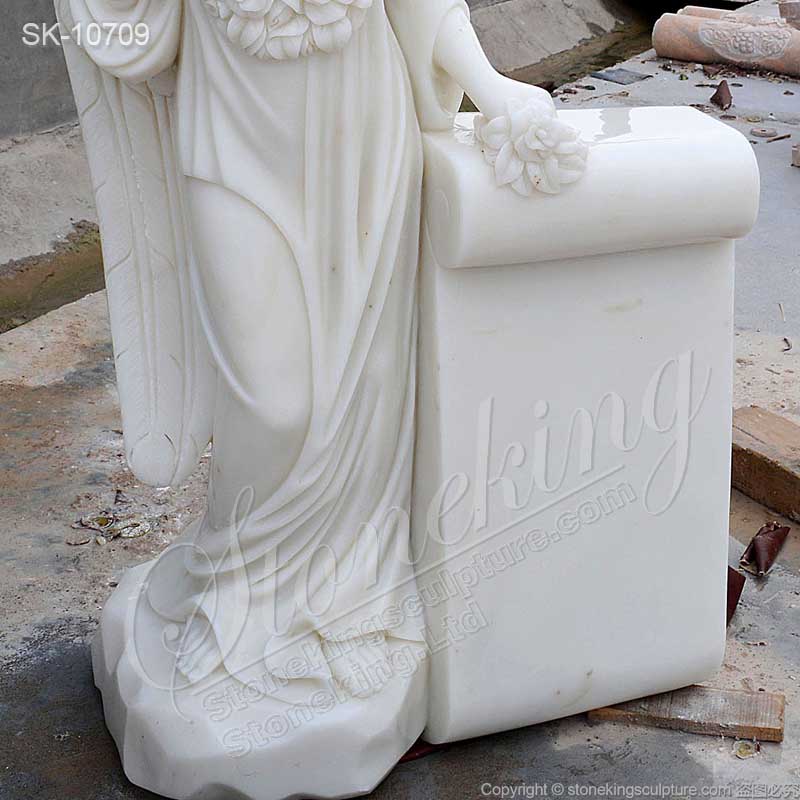
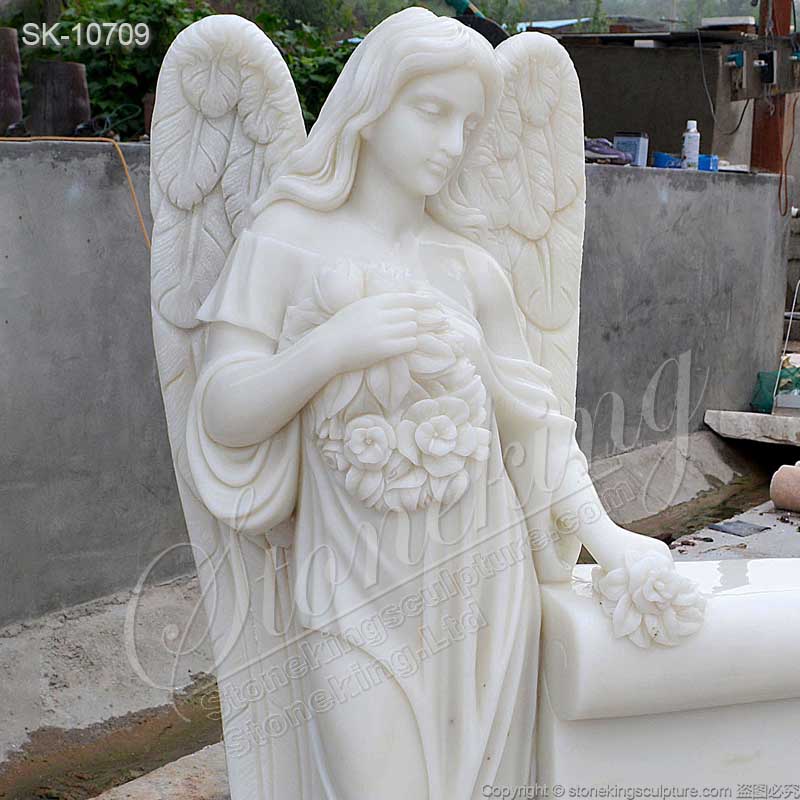
 Add to Inquiry List
Add to Inquiry List 